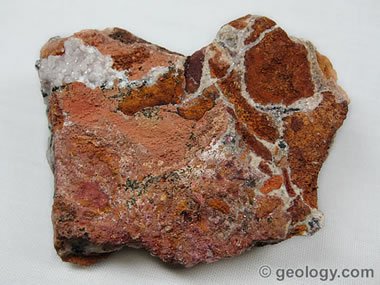Copper Mineral | Uses and Properties (original) (raw)
Mineral Properties and Uses
Article by: , PhD, RPG

Copper: Copper from Bisbee, Arizona. This specimen is approximately 2.5 inches (6.4 centimeters) across.
What is Copper?
Native copper is an element and a mineral. It is found in the oxidized zones of copper deposits; in hydrothermal veins; in the cavities of basalt that have been in contact with hydrothermal solutions; and as pore fillings and replacements in conglomerates that have been in contact with hydrothermal solutions. It is rarely found in large quantities, thus it is seldom the primary target of a mining operation. Most copper produced is extracted from sulfide deposits.
Uses of Copper
Native copper was probably one of the early metals worked by ancient people. Nuggets of the metal could be found in streams in a few areas, and its properties allowed it to be easily worked without a required processing step. Copper's metallic luster attracted people's attention. Today most copper is produced from sulfide ores.
Copper is an excellent conductor of electricity. Most copper mined today is used to conduct electricity - mostly as wiring. It is also an excellent conductor of heat and is used in cooking utensils, heat sinks, and heat exchangers. Large amounts are also used to make alloys such as brass (copper and zinc) and bronze (copper, tin, and zinc). Copper is also alloyed with precious metals such as gold and silver. Copper has many other uses.
| Physical Properties of Copper | |
|---|---|
| Chemical Classification | Native element |
| Color | Copper red on a fresh surface, dull brown on a tarnished surface |
| Streak | Metallic copper red |
| Luster | Metallic |
| Diaphaneity | Opaque |
| Cleavage | None |
| Mohs Hardness | 2.5 to 3 |
| Specific Gravity | 8.9 |
| Diagnostic Properties | Color, luster, specific gravity, malleability, ductility |
| Chemical Composition | Copper, Cu |
| Crystal System | Isometric |
| Uses | Conducts electricity and heat; wiring, electrical contacts and circuits; coinage, alloys |
The best way to learn about minerals is to study with a collection of small specimens that you can handle, examine, and observe their properties. Inexpensive mineral collections are available in the Geology.com Store. Image copyright iStockphoto / Anna Usova.
Find Other Topics on Geology.com:
 Rocks: Galleries of igneous, sedimentary and metamorphic rock photos with descriptions. Rocks: Galleries of igneous, sedimentary and metamorphic rock photos with descriptions. |
 Minerals: Information about ore minerals, gem materials and rock-forming minerals. Minerals: Information about ore minerals, gem materials and rock-forming minerals. |
|---|---|
 Volcanoes: Articles about volcanoes, volcanic hazards and eruptions past and present. Volcanoes: Articles about volcanoes, volcanic hazards and eruptions past and present. |
 Gemstones: Colorful images and articles about diamonds and colored stones. Gemstones: Colorful images and articles about diamonds and colored stones. |
 General Geology: Articles about geysers, maars, deltas, rifts, salt domes, water, and much more! General Geology: Articles about geysers, maars, deltas, rifts, salt domes, water, and much more! |
 Geology Store: Hammers, field bags, hand lenses, maps, books, hardness picks, gold pans. Geology Store: Hammers, field bags, hand lenses, maps, books, hardness picks, gold pans. |
 |
 Diamonds: Learn about the properties of diamond, its many uses, and diamond discoveries. Diamonds: Learn about the properties of diamond, its many uses, and diamond discoveries. |
